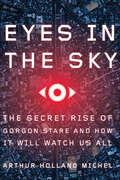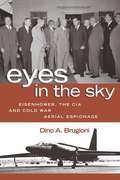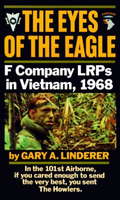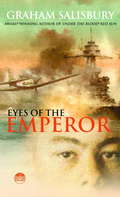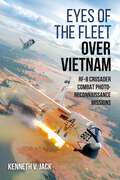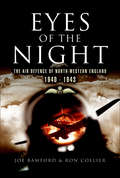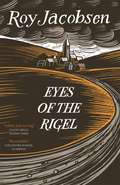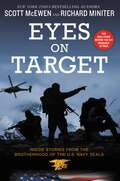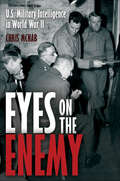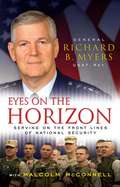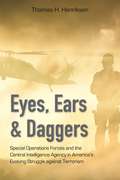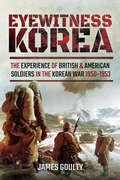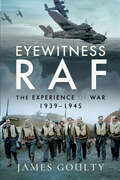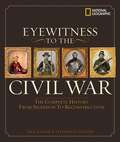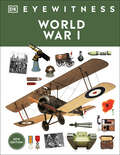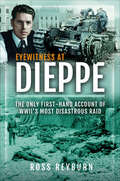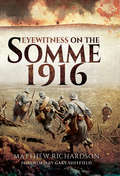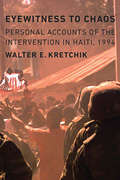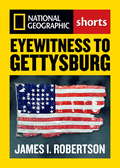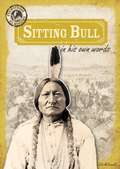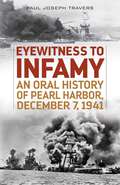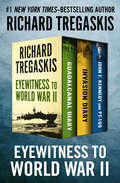- Table View
- List View
Eyes In The Sky: The Secret Rise of Gorgon Stare and How It Will Watch Us All
by Arthur Holland MichelThe fascinating history and unnerving future of high-tech aerial surveillance, from its secret military origins to its growing use on American citizensEyes in the Sky is the authoritative account of how the Pentagon secretly developed a godlike surveillance system for monitoring America's enemies overseas, and how it is now being used to watch us in our own backyards. Whereas a regular aerial camera can only capture a small patch of ground at any given time, this system—and its most powerful iteration, Gorgon Stare—allow operators to track thousands of moving targets at once, both forwards and backwards in time, across whole city-sized areas. When fused with big-data analysis techniques, this network can be used to watch everything simultaneously, and perhaps even predict attacks before they happen. In battle, Gorgon Stare and other systems like it have saved countless lives, but when this technology is deployed over American cities—as it already has been, extensively and largely in secret—it has the potential to become the most nightmarishly powerful visual surveillance system ever built. While it may well solve serious crimes and even help ease the traffic along your morning commute, it could also enable far more sinister and dangerous intrusions into our lives. This is closed-circuit television on steroids. Facebook in the heavens. Drawing on extensive access within the Pentagon and in the companies and government labs that developed these devices, Eyes in the Sky reveals how a top-secret team of mad scientists brought Gorgon Stare into existence, how it has come to pose an unprecedented threat to our privacy and freedom, and how we might still capitalize on its great promise while avoiding its many perils.
Eyes Turned Skyward: A Novel
by Alena Dillon"Eyes Turned Skyward is a powerful examination of the cost—emotional, familial, generational—when women are denied their right to soar... Alena Dillon's poetic prose and complex characters will linger long after the last page is turned!" — Kate Quinn, New York Times bestselling authorFrom the author of Mercy House and The Happiest Girl in the World comes a brilliant, dual timeline novel about a daughter discovering her mother’s past as a female pilot during World War II and the consequences of women’s contributions remaining unrecognized.Kathy Begley is an empty nester, the primary caretaker of her ailing mother, and the emotional support for her laid-off husband. She’s also returning to the office after two decades to work under a borderline inappropriate boss. Then a Congressional Gold Medal Ceremony invitation arrives, and she uncovers an unfathomable family secret: her mother, Peggy Mayfield, wasn’t just a tempestuous wife and mother. She was a Women Airforce Service Pilot.Peggy jumped at the opportunity to become a WASP, the first American females to fly military aircraft. She wore men’s uniforms, sweated, studied, trained, and soared. She also danced, drank, played poker, and fell in love with adventure, new friends, and her commanding officer.Once a spunky flyer, Peggy is now filled with regret as she confronts the end of her life, but Kathy is determined to make her last months count by securing Peggy long overdue recognition, appreciating her anew, and forgiving her before it’s too late.Eyes Turned Skyward is an unforgettable novel about unheralded female heroism, the transformation of misogyny, inheritance, and ultimately, reconciliation.
Eyes in the Sky
by Dino A. BrugioniDino A. Brugioni, author of the best-selling account of the Cuban Missile crisis, Eyeball to Eyeball, draws on his long CIA career as one of the world's premier experts on aerial reconnaissance to provide the inside story of President Dwight D. Eisenhower's efforts to use spy planes and satellites to gather military intelligence. He reveals Eisenhower to be a hands-on president who, contrary to popular belief, took an active role in assuring that the latest technology was used to gather aerial intelligence. This previously untold story of the secret Cold War espionage program makes full use of the author's own firsthand knowledge and of the information gained from interviews with important participants. As a founder and senior officer of the CIA's National Photographic Interpretation Center, Brugioni was a key player in keeping Eisenhower informed of all developments, and he sheds new light on the president's contributions toward building an effective and technologically advanced aerial reconnaissance organization.Eyes in the Sky provides details of the president's backing of the U-2's development and its use to dispel the bomber gap, to provide data on Soviet missile and nuclear efforts and to deal with crises in the Suez, Lebanon, Chinese Off Shore Islands, Tibet, Indonesia, East Germany, and elsewhere. Brugioni offers new information about Eisenhower's order of U-2 flights over Malta, Cyprus, Toulon, and Israel and subsequent warnings to the British, French, and Israelis that the U.S. would not support an invasion of Egypt. He notes that the president also backed the development of the CORONA photographic satellite, which eventually proved the missile gap with the Soviet Union didn't exist, and a variety of other satellite systems that detected and monitored problems around the world.
Eyes of the Eagle
by Gary LindererWhen Gary Linderer reached Vietnam in 1968, he volunteered for training and duty with the F Company 58th In, the Long Range Patrol Company that was "the Eyes of the Eagle." F Company pulled reconnaisssance missions and ambushes, and Linderer recounts night insertions into enemy territory, patrols against NVA antiaircraft emplacements, and some of the bravest demonstrations of courage under fire that has ever been described....From the Paperback edition.
Eyes of the Emperor
by Graham SalisburyEddy Okubo lies about his age and joins the army in his hometown of Honolulu only weeks before the Japanese bomb Pearl Harbor. Suddenly Americans see him as the enemy--even the U.S. Army doubts the loyalty of Japanese American soldiers.Then the army sends Eddy and a small band of Japanese American soldiers on a secret mission to a small island off the coast of Mississippi. Here they are given a special job, one that only they can do. Eddy's going to help train attack dogs. He's going to be the bait.
Eyes of the Fleet Over Vietnam: RF-8 Crusader Combat Photo-Reconnaissance Missions
by Kenneth V. JackThis military study of the air war in Vietnam offers a vividly detailed examination of the critical role played by unarmed photo recon aircraft. While photo reconnaissance was a critical factor in the Vietnam War, its methods and operations remained a classified secret for many years. In Eyes of the Fleet Over Vietnam, veteran and historian Kenneth V. Jack sheds light on the subject by examining the role of the unarmed supersonic RF-8A/G photo-Crusader throughout the war, as well as the part played by its F-8 and F-4 escort fighters. The historical narrative is brought to life through vivid first-hand details of dangerous missions over Laos and North Vietnam. Jack pieces together a detailed chronology of photo recon in the Vietnam War between 1964 and 1972, describing all types of missions, including several Crusader vs. MiG dogfights and multiple RF-8 shootdowns with their associated, dramatic rescues. The narrative focuses on Navy Photo Squadron VFP-63, but also dedicates chapters to VFP-62 and Marine VMCJ-1.
Eyes of the Night: Air Defence of North-western England, 1940–41
by Ron Collier Joe BamfordA history of 9 Group, Royal Air Force Fighter Command, formed specifically to protect Liverpool and Manchester during the darkest hours of WWII. In the early years of World War II, two of Britain&’s most important industrial cities, Liverpool and Manchester, were woefully unprotected from enemy bombing raids. Once the capitulation of France had occurred after Dunkirk, the Luftwaffe was able to base its vast bomber fleet at forward airfields that brought these strategic targets within their range. The effect was catastrophic and the two cities and surrounding industrial centers bore the brunt of the Nazi airborne blitz. It was clear that more anti-aircraft guns and fighter aircraft were desperately required to stop the slaughter of the population and vital industries. Thus was conceived 9 Group of the Royal Air Force, charged with the air defense of the entire region. This book relates how the Group was formed and the immense difficulties involved—due to shortages of suitable aircraft, guns and operational infrastructure. Fought mostly at night during a period when night-fighter tactics were in their infancy and inexperienced aircrew were having to fly over difficult mountainous terrain and in appalling weather conditions resulting in a high casualty rate. Eventually things improved and the Squadrons within 9 Group started to bring down significant numbers of raiding bombers whether they approached from the East or took advantage of neutral Ireland&’s street lights to guide them via the Irish Sea to their intended targets.
Eyes of the Rigel
by Roy JacobsenThe third novel in a historical trilogy that began with the International Booker shortlisted The Unseen "Taken together, Jacobsen has given us an epic of Norway's experience of the first half of the 20th century that is subtle and moving" David Mills, Sunday Times"Jacobsen can make almost anything catch the light . . . One of Norway's greatest writers on the working class" Times Literary SupplementThe journey had taken on its own momentum, it had become an autonomous, independent entity, she was searching for love, and was still happily unaware that truth is the first casualty of peace. The long war is over, and Ingrid Barroy leaves the island that bears her name to search for the father of her child.Alexander, the Russian captive who survived the sinking of prisoner ship the Rigel and found himself in Ingrid's arms, made an attempt to cross the mountains to Sweden. Ingrid will follow in his footsteps, carrying her babe in arms, the child's dark eyes the only proof that she ever knew him.Along the way, Ingrid's will encounter collaborators, partisans, refugees, deserters, slaves and sinners, in a country that still bears the scars of defeat and occupation. And before her journey's end she will be forced to ask herself how well she knows the man she is risking everything to find.Translated from the Norwegian by Don Bartlett and Don ShawDon Bartlett is the acclaimed translator of books by Karl Ove Knausgård, Jo Nesbø and Per Petterson.Don Shaw, co-translator, is a teacher of Danish and author of the standard Danish-Thai/Thai-Danish dictionaries.With the support of the Creative Europe Programme of the European Union
Eyes on Target: Inside Stories from the Brotherhood of the U.S. Navy SEALs
by Scott Mcewen Richard MiniterTold through the eyes of current and former Navy SEALs, EYES ON TARGET is an inside account of some of the most harrowing missions in American history-including the mission to kill Osama bin Laden and the mission that wasn't, the deadly attack on the US diplomatic outpost in Benghazi where a retired SEAL sniper with a small team held off one hundred terrorists while his repeated radio calls for help went unheeded. The book contains incredible accounts of major SEAL operations-from the violent birth of SEAL Team Six and the aborted Operation Eagle Claw meant to save the hostages in Iran, to key missions in Iraq and Afganistan where the SEALs suffered their worst losses in their fifty year history-and every chapter illustrates why this elite military special operations unit remains the most feared anti-terrorist force in the world. We hear reports on the record from retired SEAL officers including Lt. Cmdr. Richard Marcinko, the founder of SEAL Team Six, and a former Commander at SEAL team Six, Ryan Zinke, and we come away understanding the deep commitment of these military men who put themselves in danger to protect our country and save American lives. In the face of insurmountable odds and the imminent threat of death, they give all to protect those who cannot protect themselves. No matter the situation, on duty or at ease, SEALs never, ever give up. One powerful chapter in the book tells the story of how one Medal of Honor winner saved another, the only time this has been done in US military history. EYES ON TARGET includes these special features: A detailed timeline of events during the Benghazi attack Sample rescue scenarios from a military expert who believes that help could have reached the Benghazi compound in time The US House Republican Conference Interim Progress Report on the events surrounding the September 11, 2012 Terrorist Attacks in Benghazi Through their many interviews and unique access, Scott McEwen and Richard Miniter pull back the veil that has so often concealed the heroism of these patriots. They live by a stringent and demanding code of their own creation, keeping them ready to ignore politics, bureaucracy and-if necessary-direct orders. They share a unique combination of character, intelligence, courage, love of country and what can only be called true grit. They are the Navy SEALs, and they keep their Eyes on Target.
Eyes on the Enemy: U.S. Military Intelligence in World War II
by Chris McNab"...a comprehensive reprint of the Intelligence doctrine that supported the American drive to victory on numerous fronts against a wide range of enemies and environments. It is worth the read to reinforce the basics of what we still do today." — The Vanguard: Journal of the Military Intelligence Corps Association On December 7, 1941, an imperial Japanese carrier strike force attacked the US Pacific Fleet at Pearl Harbor, taking advantage of what was one of the most profound intelligence failures in US history. Galvanized into action, the branches of the U.S. military subsequently developed one of the greatest, albeit imperfect, intelligence-gathering and analysis networks of the combatant nations, opening an invaluable window onto the intentions of their enemies. The picture of U.S. military intelligence during World War II is a complex one. It was divided between the fields of signal intelligence (SIGINT) and human intelligence (HUMINT), combat intelligence and War Department intelligence, and between numerous different organizations, including the Military Intelligence Division (MID), Military Intelligence Service (MIS), the Office of Naval Intelligence (ONI), the Counter Intelligence Corps (CIC), the Office of Strategic Services (OSS) and the many intelligence units organic to Army, Navy, Army Air Forces, and Marine Corps. The documents collected in this book reveal the theoretical and practical principles behind wartime intelligence gathering and analysis, from the frontline intelligence officer to the Washington-based code-breaker. They explain fundamentals such as how to observe and record enemy activity and intercept enemy radio traffic, through to specialist activities such as cryptanalysis, photoreconnaissance, prisoner interrogation, and undercover agent operations. The painstaking work of an intelligence operator required a sharp, attentive mind, whether working behind a desk or under fire on the frontlines. The outputs from these men and women could ultimately make the difference between victory and defeat in battle.
Eyes on the Horizon: Serving on the Front Lines of National Security
by Malcolm Mcconnell Richard MyersGeneral Richard B. Myers, Chairman of the Joint Chiefs of Staff during the critical four years following September 11, 2001, looks back over his career and provides a candid, revealing insider's view of the war on terror and proposing a bold new plan that will prepare America for the diverse national security challenges of the twenty-first century. Growing up in Kansas as the son of hardworking, no-nonsense parents, General Richard Myers, a distinguished Air Force officer for more than forty years, learned early the value of steadfast integrity and selfless service. As Chairman of the Joint Chiefs of Staff from 2001 to 2005, he bore witness to the critical events that shaped America's defense policy in the wake of the terrorist attacks of September 11, 2001. In the days, weeks, and months that followed, he worked around the clock, helping to devise innovative, unprecedented strategies for the Bush administration's war on terror in Afghanistan and Iraq and advising the president on tough, historic national security decisions. In this captivating memoir, General Myers talks candidly about his career in the military, the unforgettable events of September 11, and the global war on terror. With an insider's perspective, he outlines the mistakes made by the White House, Pentagon leadership, and the intelligence community. Myers believes that America has misidentified its adversary, focusing too narrowly on tactical battles, instead of on a long-range strategy that will overcome a global insurgency fueled by a struggle for control within Islam. The United States must rely not just on the military, but also on intelligence and other instruments of national power and work through extant governments to reverse the depiction of an American-led crusade against Muslims. Rather than identify what Islam should become, we must work with an international community that includes responsible non-Western states to protect against the behaviors we consider universally unacceptable -- especially those that promote violence against the U.S. and its allies or any other country or society affected by the struggle within Islam. Finally, Myers maintains we must integrate our own government agencies so that we can focus a sustained approach to this strategy. Told with unfailing honesty, Eyes on the Horizon is an unforgettable memoir of one of our nation's highest ranking officers and a courageous call for change that will strengthen American national security and defend a democratic way of life.
Eyes, Ears & Daggers: Special Operations Forces and the Central Intelligence Agency in America's Evolving Struggle against Terrorism
by Thomas H. HenriksenThomas H. Henriksen examines the warrior-spy connection both before and after the formation of the SOF and the CIA. Henriksen shows how, by adopting an intelligence-driven, targeted counter strike weapon against terrorists, the United States went from a Cold War Goliath to a more nimble force, thanks largely to the SOF and CIA contributions.
Eyewitness Korea: The Experience of British and American Soldiers in the Korean War, 1950–1953
by James GoultyToday the Korean War of 1950-1953 is overshadowed by later twentieth-century conflicts in Vietnam and the Middle East, yet at the time it was the focus of international attention.It threatened to lead to a third world war, and although fought on a limited scale, it still involved over a million men under UN command and even more on the Communist side. It left the American and British troops who took part with a range of intense recollections that often marked them for the rest of their lives, and it is these experiences that James Goulty draws on in this eyewitness history of the conflict.He uses official documents, letters, diaries, regimental histories, memoirs, oral histories and correspondence to show what the war was like for those who took part. Their accounts vividly contrast the American and British experience as seen through the eyes of individual servicemen, and they throw fresh light on the relations between the UN forces on their different attitudes, tactics, training and equipment, and on the tensions that developed between them.
Eyewitness RAF: The Experience of War, 1939–1945
by James GoultyA detailed, realistic picture of what it was like to serve in the Royal Air Force during WWII, both on the ground and in the air, using firsthand accounts.Much has been written about the Royal Air Force during the Second World War—memoirs, biographies, histories of Fighter and Bomber commands, technical studies of the aircraft, accounts of individual operations and exploits—but few books have attempted to take the reader on a journey through basic training and active service as air or ground crew and eventual demobilization at the end of the war. That is the aim of James Goulty’s Eyewitness RAF. Using a vivid selection of testimony from men and women, he offers a direct insight into every aspect of wartime life in the service.Throughout the book the emphasis is on the individual’s experience of the RAF—the preparations for flying, flying itself, the daily routines of an air base, time on leave, and the issues of discipline, morale, and motivation. A particularly graphic section describes, in the words of the men themselves, what it felt like to go on operations and the impact of casualties—airmen who were killed, injured, or taken prisoner.What emerges is a fascinatingly varied inside view of the RAF that is perhaps less heroic and glamorous than the image created by some postwar accounts—but gives readers today a much more realistic appreciation of the whole gamut of life in the RAF seventy-plus years ago.
Eyewitness RAF: The Experience of War, 1939–1945
by James GoultyA detailed, realistic picture of what it was like to serve in the Royal Air Force during WWII, both on the ground and in the air, using firsthand accounts.Much has been written about the Royal Air Force during the Second World War—memoirs, biographies, histories of Fighter and Bomber commands, technical studies of the aircraft, accounts of individual operations and exploits—but few books have attempted to take the reader on a journey through basic training and active service as air or ground crew and eventual demobilization at the end of the war. That is the aim of James Goulty’s Eyewitness RAF. Using a vivid selection of testimony from men and women, he offers a direct insight into every aspect of wartime life in the service.Throughout the book the emphasis is on the individual’s experience of the RAF—the preparations for flying, flying itself, the daily routines of an air base, time on leave, and the issues of discipline, morale, and motivation. A particularly graphic section describes, in the words of the men themselves, what it felt like to go on operations and the impact of casualties—airmen who were killed, injured, or taken prisoner.What emerges is a fascinatingly varied inside view of the RAF that is perhaps less heroic and glamorous than the image created by some postwar accounts—but gives readers today a much more realistic appreciation of the whole gamut of life in the RAF seventy-plus years ago.
Eyewitness To The Civil War: The Complete History from Secession to Reconstruction
by Stephen G. Hyslop Neil Kagan Harris J. AndrewsAt once an informed overview for general-interest readers and a superb resource for serious buffs, this extraordinary, gloriously illustrated volume is sure to become one of the fundamental books in any Civil War library. Its features include a dramatic narrative packed with eyewitness accounts and hundreds of rare photographs, artifacts, and period illustrations. Evocative sidebars, detailed maps, and timelines add to the reference-ready quality of the text. From John Brown's raid to Reconstruction, "Eyewitness to the Civil War" presents a clear, comprehensive discussion that addresses every military, political, and social aspect of this crucial period. <p><p> In-depth descriptions of campaigns and battles in all theaters of war are accompanied by a thorough evaluation of the nonmilitary elements of the struggle between North and South. In their own words, commanders and common soldiers in both armies tell of life on the battlefield and behind the lines, while letters from wives, mothers, and sisters provide a portrait of the home front. <p> More than 375 historical photographs, portraits, and artifacts--many never before published--evoke the era's flavor; and detailed maps of terrain and troop movements make it easy to follow the strategies and tactics of Union and Confederate generals as they fought through four harsh years of war. Photoessays on topics ranging from the everyday lives of soldiers to the dramatic escapades of the cavalry lend a breathtaking you-are-there feeling, and an inclusive appendix adds even more detail to what is already a magnificently meticulous history.
Eyewitness World War I (DK Eyewitness)
by DKPacked with striking photography, Eyewitness World War I explores one of the most brutal conflicts of the 20th century.Become an eyewitness to the first conflict fought on a global scale in this picture-led reference guide that will take you on a visual tour of World War One. Made in collaboration with The Imperial War Museum, children will be mesmerized by learning about the world-changing events that led to the start of the conflict.This beautifully illustrated guide for kids aged 9+ gives an insight into life in the muddy trenches and what it was like to be a soldier, along with a broader picture of the events that took place causing the war to start. Using striking full-color photographs and illustrations of warfare, weaponry, vehicles, maps, and secret documents, this is an eyewitness view of the conflict dubbed the &“the war to end all wars&”.Throughout the pages of this newly-revised book on the First World War, you can expect to find: - A fresh new look; new photographs, updated information, and a new &“eyewitness&” feature.- Amazing facts, updated diagrams, statistics, and timelines.- Brand new eyewitness accounts from experts in the field.Eyewitness World War I introduces the ultimate guide to the first global conflict, with more than 250 photographs illustrating the people, places and stories of the war. Children can learn all about military vehicles and tank warfare, the first ever gas attacks used during a war and Armistice and peace after four years of fighting. This all-encompassing guide to World War One is a must-have for curious children aged 9+ with a thirst for learning, as well as teachers, parents and librarians.So, what&’s new? Part of DK&’s best-selling Eyewitness series, this popular title has been reinvigorated for the next generation of information-seekers and stay-at-home explorers, with a fresh new look, up to 20 percent new images, including photography and updated diagrams, updated information, and a new &“eyewitness&” feature with fascinating first-hand accounts from experts in the field.Explore the series!Globally, the Eyewitness series has sold more than 50 million copies over 30 years. Travel through the solar system with Eyewitness Space, learn the incredible systems that keep your body functioning with Eyewitness Human Body, or take a trip aboard the most famous ship in history with Eyewitness Titanic.
Eyewitness at Dieppe: The Only First-Hand Account of WWII's Most Disastrous Raid
by Ross ReyburnIn August 1942, Allied forces mounted an attack on the German-held port of Dieppe; titled Operation Jubilee, it represented a rehearsal for invasion. The amphibious attack saw over 6,000 infantrymen, predominantly Canadian, put ashore, tasked with destroying German structures and gathering intelligence. The doomed raid was an abject failure, and became Canada’s worst military disaster. Eyewitness at Dieppe is a long-overdue reissue of New Zealand-born writer Wallace Reyburn’s dramatic account of the raid. He was with the first soldiers clambering ashore, and aboard the last ship returning to England after six hours of carnage. Awarded an OBE as the only war correspondent to witness the street fighting first-hand, Reyburn was fortunate not be numbered among Dieppe’s dead, suffering just a minor wound inflicted by mortar shell fragments. His book, Rehearsal for Invasion was a wartime bestseller. Accompanied by freelance journalist Ross Reyburn’s new foreword on his father’s account, this new edition tells us more about Wallace’s intriguing life and details the shortcomings of his father’s book, dictated by wartime censorship corrected in the post-war years through a withering condemnation of raid’s mastermind Lord Mountbatten.
Eyewitness on the Somme 1916
by Matthew RichardsonWhat was the soldiers experience of the Battle of the Somme? How did the men who were there record their part in the fighting or remember it afterwards? How can we, 100 years later, gain an insight into one of the most famous and contentious - episodes of the Great War? Matthew Richardsons graphic account, which is based on the vivid personal testimony of those who took part, offers us a direct impression of the reality of the battle from the perspective of the ordinary soldiers and junior officers on the front line. He draws heavily on previously unpublished personal accounts letters, diaries, and memoirs, some never before translated into English to build up a multifaceted picture of the Somme offensive from the first disastrous day of the attack, through the subsequent operations between July and November 1916. In their own words, the soldiers who were caught up in the conflict recall in unflinching detail the fighting across the entire Somme battlefield. The narrative features the recollections of British, Commonwealth, French and American soldiers, and interweaves their testimony with descriptions left by their German adversaries. For the first time in a single volume, the reader has the opportunity to explore all facets of this momentous five-month-long struggle. Over 100 black-and-white contemporary photographs, many previously unpublished, accompany the text, whilst a selection of artifacts recovered from the battlefield is illustrated in colour. These striking objects bear silent witness to the ferocity of the battle, and often reflect some moment of personal tragedy.
Eyewitness to America: 500 Years of America in the Words of Those Who Saw it Happen
by David Colbert"The Admiral [Columbus] sailed west-southwest, at the rate of ten miles an hour and occasionally twelve, and at other times seven, running between day and night fifty-nine leagues; he told the men only forty-four. Here the crew could stand it no longer, they complained of the long voyage, but the Admiral encouraged them as best he could, giving them hopes of the profits that they might have. And he added that it was useless to murmur because he had come in search of the Indies, and was going to continue until he found them with God's help." Figures from our history come alive as we read their words and the words of those who were with them. An exciting, fascinating and easy-to-read history.
Eyewitness to Chaos: Personal Accounts of the Intervention in Haiti, 1994
by Walter E. KretchikIn September 1994 a large U.S. invasion force converged on Haiti. Years of diplomatic efforts, secret government planning, and military rehearsals on the parts of the United States and the United Nations had failed to restore to office Haiti’s democratically elected, junta-deposed president, Jean-Bertrand Aristide, and now invasion was imminent. Poised for action and mere minutes from striking, President Bill Clinton stunned military commanders when he announced a drastic change of plan: a peaceful cooperation with an illegal government. In Eyewitness to Chaos Walter E. Kretchik retells the experience of this unprecedented and convoluted operation through the voices of its participants. Synthesizing accounts from a cross section of military officials, Kretchik unveils the little-known inner workings of government and military planning and the real-world quandaries of operational execution faced by those involved. The thirty-seven interviewees provide insight into the many facets of the operation: strategic and operational planning; intelligence gathering; multinational force design; medical and legal complications; communication concerns; contracting and logistics; ethnic, cultural, and historical considerations; mission execution; and language barriers. What emerges is a new perspective on this attempt to secure a brighter future for Haiti’s people.
Eyewitness to Gettysburg
by Stephen G. HyslopJames Robertson, one of America's most respected Civil War scholars and storytellers whose weekly talks about little-known people and events of the Civil War aired for 15 years on National Public Radio, brings history to life here in a collection of unexpected and true stories revealing the events that took place as great events unfolded. He explores such gripping subjects as the post-battle horrors of the wounded, the destruction of Robert E. Lee's aura of invincibility, and the invention of a new way to remove the wounded from the battlefield. In addition, an introductory overview of the Civil War traces the major events of the conflict year by year. Painstakingly researched and deeply personal, this ebook offers a unique reading experience for the millions of Civil War buffs and all those interested in the previously untold stories behind this great chapter in America's past.
Eyewitness to History: Sitting Bull in His Own Words
by Julia McdonnellSitting Bull, the well-known Native American chief, united the Lakota Sioux in the northern Great Plains and led a mighty resistance of tribes who refused to be placed on reservations. This struggle resulted in violence, most famously at Little Bighorn in 1876. Though Sitting Bull fled to Canada, he ultimately returned to the United States in 1881. This book uses Sitting Bull's powerful words to examine the leader's considerable courage and determination as well as his aspirations for Native Americans.
Eyewitness to Infamy: An Oral History of Pearl Harbor
by Paul Joseph TraversThe Japanese attack on Pearl Harbor changed the lives of almost every American, and began the process of putting 17 million of them in uniform to fight in World War II. Yet in the long and fascinating body of literature about this terrible event, most historians have neglected the compelling and moving accounts of the surviving military personnel and civilians who were on Oahu at the time of the attack, at dawn on December 7, 1941.Eyewitness to Infamy is their story—the astonishing oral history of the brutal attack that pushed the United States into WWII on the side of the Allies: the British, French, and Russians. With the help of the Pearl Harbor Survivors&’ Association, the Veterans of Foreign Wars, and the American Legion, Paul Travers collected more than 200 eyewitness accounts from which he painstakingly selected those critical to this behind-the-scenes narrative account. With breathtaking clarity, the narratives cover the full range of military activity on the island, along battleship row, and around the harbor, while portraying the human side of the event—the heroic, the tragic, and the terrible reality of the assault.
Eyewitness to World War II: Guadalcanal Diary, Invasion Diary, and John F. Kennedy and PT-109
by Richard TregaskisThree classic accounts of WWII from a reporter who &“shaped America&’s understanding of the war, and influenced every account that came after&” (Mark Bowden). Volunteer combat correspondent Richard Tregaskis risked life and limb to give American readers a soldier&’s–eye view of the Second World War. These three tales of bravery and sacrifice shed light on the Greatest Generation&’s darkest hours. Guadalcanal Diary: In August 1942, Tregaskis landed with the US Marines on Tulagi and Guadalcanal Islands in the South Pacific for the first major Allied offensive against Japanese forces. He details the first two months of the campaign and describes the courage and camaraderie of young marines who prepared for battle knowing that one in four of them wouldn&’t make it home. An instant #1 New York Times bestseller and the basis for a popular film of the same name, Guadalcanal Diary is a masterpiece of war journalism that &“captures the spirit of men in battle&” (John Toland). Invasion Diary: In July 1943, Tregaskis joined the Allied forces in Sicily and Italy and documented some of the fiercest fighting of the war, from bombing runs over Rome to the defense of the Salerno beachhead against heavy artillery fire to the fall of Naples. In compelling and evocative prose, Tregaskis depicts the terror and excitement of life on the front lines and his own harrowing brush with death when a chunk of German shrapnel pierced his helmet and shattered his skull. Invasion Diary is &“required reading for all who want to know how armies fight&” (Library Journal). John F. Kennedy and PT-109: In the early morning hours of August 2, 1943, the Japanese destroyer Amagiri sliced into US Navy motor torpedo boat PT-109 near the Solomon Islands. Ten surviving crewmembers and their young skipper, Lt. John F. Kennedy, clung to the wreckage. Over the next three days, the privileged son of a Boston multimillionaire displayed extraordinary courage and leadership as he risked his life to shepherd his crew to safety and coordinate a daring rescue mission deep in enemy territory. Lieutenant Kennedy earned a Navy and Marine Corps Medal and a Purple Heart, and the story of PT-109 captured the public&’s imagination and helped propel Kennedy all the way to the White House. Acclaimed war correspondent Tregaskis—who once beat out the future president for a spot on the Harvard University swim team—brings this remarkable chapter in American history to vivid life.
